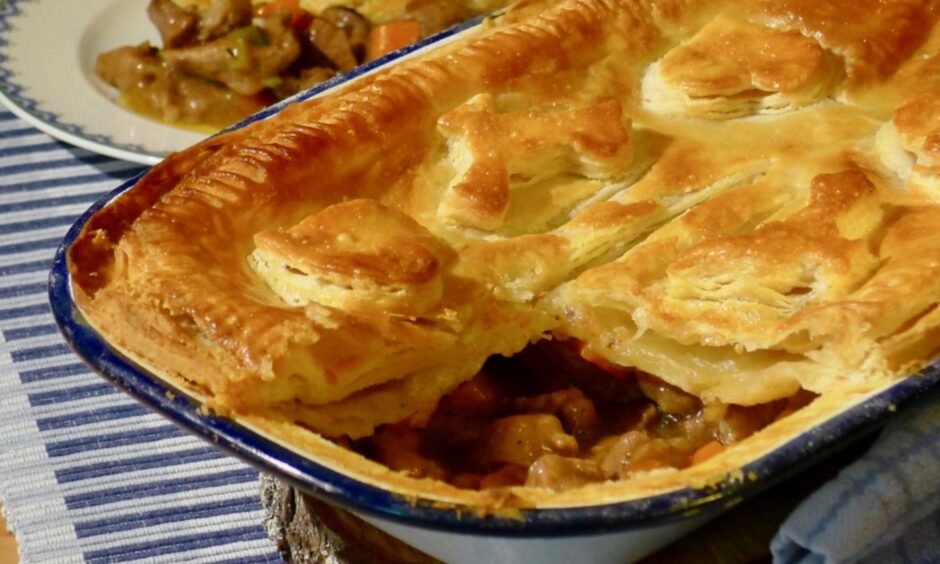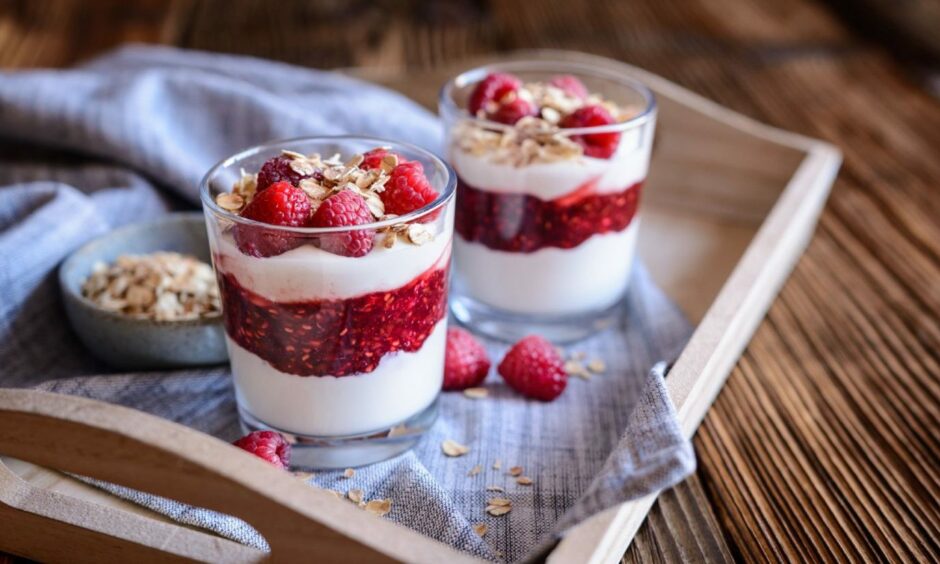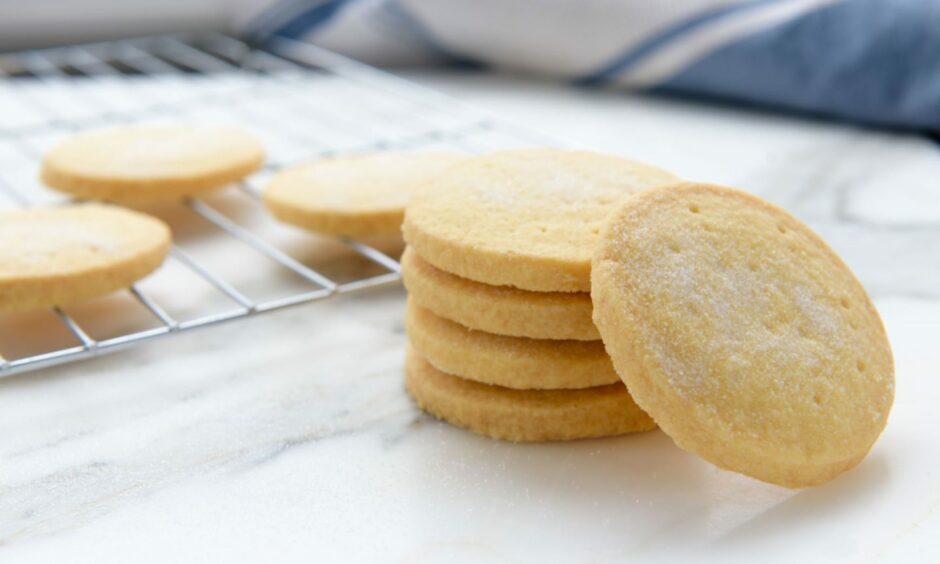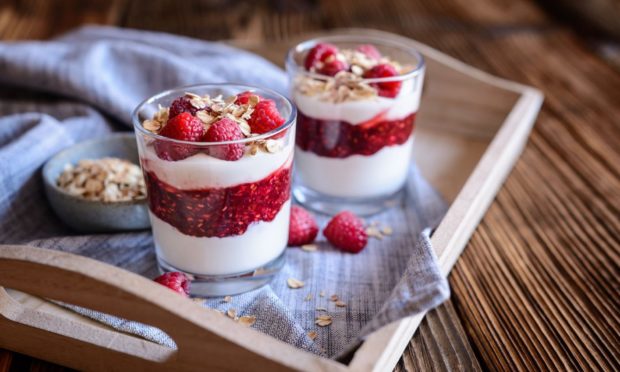With its various food and drink-related traditions in Scotland, the New Year is the perfect time to have a foodie feast.
Perhaps more so than for Christmas, us Scots have many food traditions we follow for both Hogmanay and on New Year’s Day.
Be it a warming steak pie, a cranachan for dessert or even some traditional shortbread to enjoy later on in the day, we really do know how to welcome the New Year in style.
So, why not have a go at these foodie feasts, grab your favourite tipple and tuck in.
Steak pie
(Serves 4)

Ingredients
- 1kg braising steak, cut in chunks
- 1 large carrot, peeled and diced
- A drizzle of rapeseed oil
- 1 leek, cleaned and sliced
- 6 juniper berries, crushed
- A pinch of marjoram
- 2 bay leaves
- Scottish sea salt and black pepper
- 500ml ale
- 10g cornflour
- 225g rough puff pastry
- 1 beaten egg to glaze
For the rough puff pastry:
- 225g plain flour
- 150g chilled butter
- ¼ tsp Scottish sea salt
- Juice of half a lemon
- 125ml cold water
Method
- Heat oil in pan and saute meat until thoroughly browned. Season with salt, herbs and spice. Add carrot and leek, cook for 5 minutes then cover with beer. Lid on and simmer for over an hour.
- Taste to adjust seasoning and to check the meat is tender. If not, give it a further half hour. Thicken the gravy by adding cornflour with a little water and bring to the boil to thicken, stirring all the time.
- Spoon into your pie dish (10inch/25cm) and set aside to cool. When ready, preheat oven to 220°C/Fan 210°C/415°F/Gas Mark 6.5. Roll out rough puff pastry on a floured board and use to cover your pie dish, moistening the edges of the dish first with egg wash.
- Trim the edges neatly and use trimmings for decoration. Egg glaze all the pastry and place in the hot oven. The pastry needs to bake for about 20 minutes to rise and set then turn the heat down to 180°C/Fan 160°C/350°F/Gas Mark 4 to allow the filling to thoroughly heat through for 30-45 minutes.
- Placing a sheet of baking parchment over your pie will prevent the pastry from burning.
- For the rough puff pastry: Rub 50g butter into seasoned flour until it resembles breadcrumbs.
- Cut the remaining butter into cubes and add to bowl. Move lightly around with your hands to distribute the butter cubes evenly through the flour.
- Add lemon juice and most of but not all the water and bring together with a palette knife, taking care not to mash up the butter. Add remaining water if necessary.
- Turn the mass on to a floured sheet of baking parchment and shape into an oblong.
- Fold up in thirds to resemble a brick, using the paper to help you.
- Wrap up and chill in fridge for an hour. Remove from fridge.
- Roll and fold in three again, three more times – four in all. Roll out as required or chill in fridge until ready to use.
Recipe by Wendy Barrie founder and director of award-winning scottishfoodguide.scot and scottishcheesetrail.com.
Nick Nairn’s boozy cranachan
(Serves 4)

Ingredients
- 25g soft brown sugar
- 40g pinhead oatmeal
- 300ml double cream
- 2 tbsp Scotch whisky
- 2 tbsp honey
- 225g frozen Scottish raspberries, plus extra to decorate
- 1 tbsp Drambuie
Method
- Place a frying pan over a medium heat and when hot, sprinkle in the sugar. Allow the sugar to melt without stirring then turn up the heat.
- When the sugar has begun to caramelise and turn golden brown, mix in the oats and stir, but don’t allow this to burn.
- When cooked, tip the oats and sugar on to a large piece of non-stick baking parchment and cool completely. Once cold and solid, break into pieces then grind to a coarse powder in a pestle and mortar.
- Whip the cream to a soft peak stage so that it’s thickened but still slightly floppy. Stir in the honey and whisky.
- Set a handful of the raspberries aside for decoration and toss the remainder with the Drambuie.
- To serve, sprinkle a layer of the oatmeal mix into the bottom of four tall glasses. Add a layer of the raspberries then top with the cream. Tumble the extra raspberries on top and serve immediately before the oatmeal goes soggy.
Recipe by Nick Nairn for Graham’s the Family Dairy.
Ultimate shortbread
(Makes 20)
This recipe is by former Great British Bake Off contestant James Morton for Graham’s the Family Dairy. James says: “This is the single simplest recipe there is and probably ever will be. The worst thing you can do is change it.”

Ingredients
- 50g caster sugar
- 100g unsalted butter, cold
- 150g plain flour
Method
- First, line a baking tray with a sheet of non-stick greaseproof paper. There’s no need to grease either side – the biscuits are plenty buttery to stop any stickage.
- Using your hands or a wooden spoon, smoosh together your sugar and butter in a large bowl. You do not want to “cream them until light and fluffy” like in a cake – you just want them combined.
- Add your flour and use your hands to bring the mix together into a soft dough – this can take a bit of work.
- Don’t overdo it, otherwise you’ll end up with cardboardy shortbread. After this, wrap the dough in cling film and place in the fridge. You should leave it at least half an hour, but up to 2 days. When you are ready to roll, preheat your oven to 160°C/140°C Fan/300°F/Gas Mark 2.
- Remove your shortbread from its cling film and place it on a floured surface. Sprinkle more flour on top, then roll it out (making sure it’s not sticking) until it is the thickness of a £1 coin.
- Cut into desired shapes using a biscuit cutter and place each on your prepared tray. You can re-roll when you’ve exhausted available cutting space. Once your tray is filled, prick each biscuit with a fork a few times and scatter them with sugar.
- Place the tray back in the fridge for 10-15 minutes. Think about it – shortbread is just pastry but with a bit more butter and sugar.
- The same rules apply and so the longer you chill it, the crumblier it will be. Bake your shortbread, straight from the fridge, for 10-12 minutes. They should come out pale, but with a tiny little bit of colour appearing around the edges of some of them.
- Don’t bake until golden, or else you’ll have snappy, bitter biscuits.
